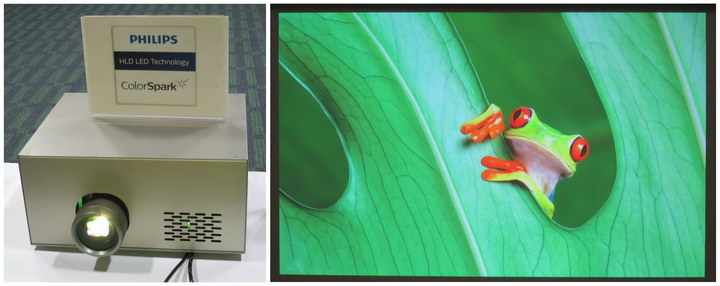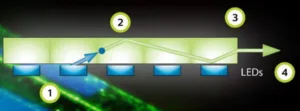In a presentation on the first day of Display Summit on Monday, June 15th, Dr. Ir. Peter Vankan from Philips announced a new product from Philips Lighting, ColorSpark.

Color Spark, also known as High Lumen Density (HLD) LED technology is targeted at the étendue limited market for LEDs in projection systems. According to Dr. Vankan, the HLD system will enable 3000 ANSI Lumen LED projectors with best-in-class colorimetry.
ColorSpark is a device to convert the output from blue LEDs to green light with a very high lumens/mm². Dr. Vankan described the operation of a ColorSpark device as:
- Blue LED light is collected in the rod.
- Inside the rod it is converted to green, forming a new light source.
- The light exits through the nose (TIR).
- The nose area and exit angle determine the light source étendue.
The details of the operation were not revealed. The best I could get Dr. Vankan to say about the technology of the system is, it’s all in the materials. I can guess how the system works but since I’m not sure, I better not guess publicly.
 ColorSpark optical unit and its drive board
ColorSpark optical unit and its drive board
According to Dr. Vankan, Philips is only planning on selling the system as a system, not as individual components. While the key phosphor conversion technology is (currently) used only in the green, he said the company will be selling it as a complete system, including red and blue LEDs.
Color converted green LEDs have been available from Osram for some time, but they have had a colorimetry problem. After you filter the OSRAM LEDs to get a good green primary, you have, at best, a modest gain over current green LEDs. When I asked Dr. Vankan how Philips avoided this colorimetry issue, he repeated it was all in the materials.
 Left: Philips demonstration ColorSpark projector. Right, an image produced by the projector.
Left: Philips demonstration ColorSpark projector. Right, an image produced by the projector.
In the Display Summit demonstration area, Philips was showing a demo projector that used ColorSpark technology. The projector was hand-built in Eindhoven and Philips has no plans to re-enter the projector business. In the Display Summit demo, the company was also showing non-operating projectors with ColorSpark technology from Hitachi and Coretronic. Dr. Vankan said that on the InfoComm show floor, there would be operating projectors with ColorSpark Technology from Optoma (with a Coretronic engine) and Hitachi.
Dr. Vankan emphasized that ColorSpark is intended to compliment the UHP lamp line for projection applications, not replace it. The best ColorSpark has achieved to date is 2722 Lumens and, in 2018 at the end of the roadmap he presented, ColorSpark will be achieving about 5000 lumens. Both numbers are based on a single DLP 0.65” WXGA imager. The UHP can do more than this now and continued development of the UHP has not and will not stop.
Philips and Insight Media have published a white paper on the human factors of ColorSpark. It can be accessed by registering Here.
Philips wasn’t the only company to discuss colorimetry on the first day of Display Summit. The opening session on high dynamic range (HDR) with Joop Telstra from Philips, Miller Schuck from RealD and Larry Thorpe from Canon included a lot of color, as an important factor in HDR. Plus there was a session dedicated to Color Accuracy with Chris Chinnock form Insight Media, Felix Pimentel from BenQ and Abhay Sharma from Sharma Consulting. If you missed Display Summit, the complete proceedings will be available next week from Insight Media. (http://www.displaysummit.com/) – Matthew Brennesholtz

